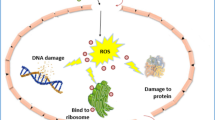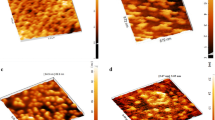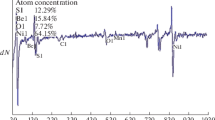Abstract
Metals in the form of nanoparticles are one of the long-term challenges for the creation of a new class of antibacterial agents. The biological activity of nanoparticles of metals depends directly on their physical and chemical properties. The objective of this work is to study the physicochemical parameters and antibacterial effects of copper nanoparticles for the standardization of the given nanomaterial during further use as an antibacterial agent. The physical and chemical parameters and antibacterial effects of copper nanoparticles are investigated. Optical methods, including atomic force microscopy, spectrophotometry, and fluorometry, are used to determine the sizes of associates of nanoparticles. The size of copper nanoparticles was 75 nm, and the sizes of nanoparticle associates are 481.1–1037 nm. An oxide film without any admixture of organic molecules is detected on the surface of nanoparticles. The antibacterial effects of copper nanoparticles are studied on the basis of clinical polyantibiotic-resistant strains of epidermal staphylococcus and gramnegative nonfermentative microorganisms (causative agents of purulent flammatory diseases among patients of traumatology and orthopedic in-patient hospital departments). As a result of the investigations, a clear antibacterial effect of copper nanoparticles with specified physical characteristics on gram-positive and gram-negative microorganisms of causative agents of wound infection is detected, which gives prospects for the further use of these particles as antibacterial agents.
Similar content being viewed by others
References
D. A. Baranov and S. P. Gubin, “Magnetic nanoparticles. Achievements and problems in chemical synthesis. Radioelectronics,” Nanosist. Inf. Tekhnol., Nos. 1–2, 129–147 (2009).
A. P. Shpak, Yu. A. Kunitskii, and V. L. Karbovskii, Cluster and Nanostructured Materials (Akademperiodika, Kiev, 2001), Vol. 1.
I. V. Babushkina, V. A. Mart’yanova, E. V. Borodulina, A. L. Borovskii, and M. Sakkala, “Nanosize copper particles impact to clinical strains of gram-negative bacteria,” Vestn. RUDN, No. 4, 162–165 (2010).
I. V. Babushkina, V. B. Borodulin, G. V. Korshunov, and D. M. Puchin’yan, “Antibacterial effect of copper nanoparticles onto clinical strains of Staphylococcus Aureus,” Saratov. Nauch.-Med. Zh., No. 1, 11–14 (2010).
I. N. Andrusishina, “Metallic nanoparticles. Synthesis procedure. Physicochemical properties. Ways for investigations and toxicity estimation,” Sovr. Probl. Toksikol., No. 3, 5–14 (2011).
A. A. Rakhmetova, Extended Abstract of Candidate’s Dissertation in Biology (Moscow, 2011).
J. Martinez-Duart, R. J. Martin-Palmer, and F. AgulloRueda, Nanotechnology for Microelectronics and Optoelectronics (Cambridge Press, 2005).
W. Schmidt, Optical Spectroscopy in Chemistry and Life Sciences: An Introduction (Wiley-VCH, 2005).
G. S. Landsberg, Optics (Nauka, Moscow, 1976) [in Russian].
T. L. Maiorova, V. G. Klyuev, V. N. Semenov, N. G. Bolgova, and A. N. Naumov, “Luminescent properties of cadmium polycrystalline films alloyed by first-groupmetals,” Vestn. VGU, No. 2, 38–44 (2005).
S. S. Kopenkin and K. A. Talitskii, “Fluroquinolones before-operation antibacterial preventive measures in traumatology and orthopaedy,” Infekts. Antimikrobn. Teropiya, No. 2, 9–13 (2007).
T. Ya. Pkhakadze, N. K. Vabishchevich, and G. G. Okroperidze, “Microbe monitoring for infectious complication in traumatology and orthopaedy,” in Proc. 3rd Russian Sci.-Practical Conf. Modern Problems in Epidemiology, Diagnosis and Preventing Measures of Hospital-Acquired Infection (St. Petersburg, 2003), pp. 97–98 [in Russian].
S. A. Bozhkov, “Modern principals of infection diagnosis and antibacterial therapy for prosthetic joints (review of published materials),” Travmatol. Ortoped. Ross., No. 3, 126–136 (2011).
Author information
Authors and Affiliations
Corresponding author
Additional information
Original Russian Text © I.A. Mamonova, M.D. Matasov, I.V. Babushkina, O.E. Losev, Ye.G. Chebotareva, E.V. Gladkova, and Ye.V. Borodulina, 2013, published in Rossiiskie Nanotekhnologii, 2013, Vol. 8, Nos. 5–6.
Rights and permissions
About this article
Cite this article
Mamonova, I.A., Matasov, M.D., Babushkina, I.V. et al. Study of physical properties and biological activity of copper nanoparticles. Nanotechnol Russia 8, 303–308 (2013). https://doi.org/10.1134/S1995078013030142
Received:
Accepted:
Published:
Issue Date:
DOI: https://doi.org/10.1134/S1995078013030142




